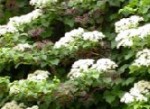 If you like to watch grass grow you might find this vine fascinating. It is a good plant and I have grown it in two different gardens but it is very slow to get established and I have yet to get any flowers. I have seen other people’s established vines covered with fragrant, lace-cap type flower heads up to 10” across and they are a magnificent sight but so far I have seen no flowers of my own. The new leaves that appear in the spring are a rich green color and form a dense mat on whatever it is growing. In winter, when the leaves fall, the stems remain, forming an attractive pattern on fence or wall. Climbing hydrangea is a deciduous perennial that climbs by adventitious roots so will grows on an arbor, on a trellis, on a pergola, or up into trees as well as fences and walls. Once the vine is established, it will grow well and can grow as much as 2’/year. The fact that it can produce great masses of flowers in partial shade makes this a very valuable plant.
If you like to watch grass grow you might find this vine fascinating. It is a good plant and I have grown it in two different gardens but it is very slow to get established and I have yet to get any flowers. I have seen other people’s established vines covered with fragrant, lace-cap type flower heads up to 10” across and they are a magnificent sight but so far I have seen no flowers of my own. The new leaves that appear in the spring are a rich green color and form a dense mat on whatever it is growing. In winter, when the leaves fall, the stems remain, forming an attractive pattern on fence or wall. Climbing hydrangea is a deciduous perennial that climbs by adventitious roots so will grows on an arbor, on a trellis, on a pergola, or up into trees as well as fences and walls. Once the vine is established, it will grow well and can grow as much as 2’/year. The fact that it can produce great masses of flowers in partial shade makes this a very valuable plant.
Type: Perennial vine.
Bloom: Small flowers are produced in dense flat heads known as lace-caps in early summer.
Light: Sun to dense shade but flowering will be less in full shade, may need some shade in South.
Size: 50’ Tall.
Soil: Humusy, moist well-drained; slightly acidic.
Fertilizer: Apply 14-7-7 fertilizer or similar in spring or fall.
Hardiness: Zones 4-9.
Care: Low maintenance; prune in summer if needed; keep the soil moist the first year and during dry periods.
Pests and Diseases: None of significance but drought and heat can predispose the plant to spider mite infestation.
Propagation: Cuttings in spring or summer.

I looked for more information on this hydrangea and both Dave’s Garden and hydrangea.com part of Wilkerson Mills Gardens give the info as zone 4-7. I am in zone 9a or 8b depending on the reference I look at. I would love to be able to use this plant can you help me?